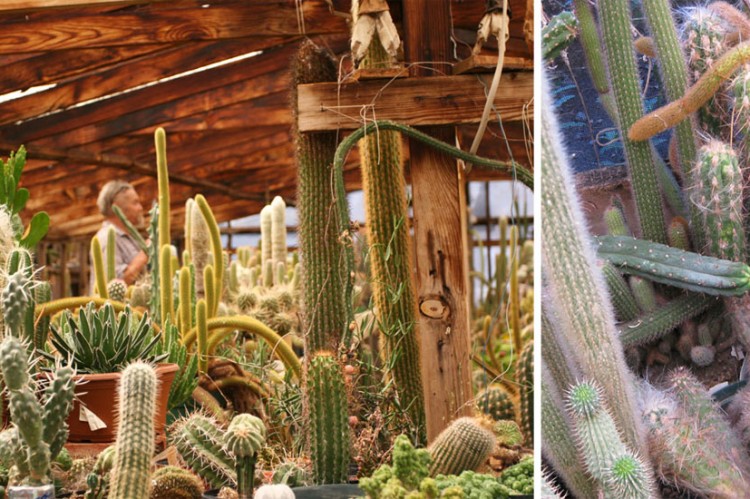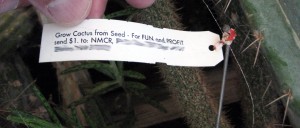New Mexico Cactus Research (NMCR) was a cactus nursery and seed supplier located in Belen, New Mexico. The business was actively operational & productive from 1980 through the 1990s and a bit beyond. There was an extremely fuzzy closing ‘date’ for reasons that will be made clear in the account below.
NMCR is still fondly remembered by many long-time cactus collectors for providing a wide range of high quality specimens of unusual cactus species at reasonable prices. Most of their former customers do not understand what happened to them so I felt this post might be welcomed. In 2010, while visiting Dr. Martin Terry, a good friend living in Texas, we were fortunate enough to be able to organize a side-trip and visit with its owners Horst & Margaret Kunzler.
Many stories abound about NMCR. Mostly they seem to have arisen from people who do not know how to say “I do not know“. My favorite baseless myth circulating on the Left Coast is that Horst came to the Southwest with a business partner who vanished without a trace in Mexico while on a seed collecting trip leaving a stunned Horst alone to become a reclusive hermit in New Mexico.
The much nicer reality is that Horst and Margaret grew up in southwestern Germany and have been together their whole adult life (they were childhood sweethearts). They are both serious cactus lovers & seed collectors who also fell in love with the desert and New Mexico when they visited in the early 1960s. Their new business named New Mexico Cactus Research was acquired from David Epple in 1963 in Belen prior to Epple moving to Bisbee and creating Arizona Cactus Research.
Their closure involved several factors but one of them involved how much business they had. For many companies too few sales can be fatal. For the cactus seed-supplying duo, it was exactly the opposite, they had so much success at attracting business with their unassuming invitation to “Grow Cactus From Seed – For FUN and PROFIT! send $1 to NMCR…” that they soon had no time to do anything else despite working very long days. By the year 2000 NMCR was being increasingly buried in orders and correspondence until it led to its owners understandably spiralling into sheer burn-out and a state of shock. This contributed to the delays in shipping reaching almost legendary status, although most often fullfillment was delayed due to Horst having to await new growth on his mother plants before orders could be completed. (I doubt anyone really minded waiting a year or more for a plant as this meant most of those delayed cuttings from NMCR arrived as the most pristine beautiful new growth possible.) The overload of orders and correspondence grew so extreme that they eventually ceased responding to their mail but they continued to fill any orders from those people who took the time to call them on the phone. Then came an unexpected catastrophic double-punch.
A few years before our visit in 2010 Horst contracted West Nile Virus from a mosquito bite and nearly died. Partly due to the virus causing encephalitis that nearly killed him, and partly due to the town of Belen confining the aging couple in a mandated lockdown quarantine of their property — making them literally prisoners inside of their own home unable to leave for any reason. If their son had not lived locally, so that there was someone who could slip food through their fence to them, it is likely that they would not have survived the ordeal. The outcome left Horst feeling lucky to be alive but with lasting health challenges including some gaps in his memory.
That same year was compounded by a hard winter with heavy snowfall. Due to Horst’s illness and slow recovery he was unable to remove the accumulated snow before it collapsed part of his greenhouse roof causing a huge loss of plants. As soon as he was physically able, Horst repaired the most intact part of the structure but closed off the rest of it as a total loss. What we were able to see when visiting them are the plants which survived. Some owe this to being hardy but the part with the specimens of most interest in answering my questions were fortuitously located on the far side of the section away from the collapse.
There are a number of comments appearing online about Horst selling confusedly identified plants. An important point, one which is true for many commercial cactus producers, is that NMCR nursery stock was originally grown from seeds with only a few exceptions. Confusion in identification can generally be tracked back to the seed supplier.
It has also been voiced that the culprit was Horst producing his seeds in an overly crowded structure where random and open cross-pollination was more probable than not. Horst told us that he never listed or sold any seed that his plants produced and did not use them for growing his sales stock as he wanted everything to be correctly identified. As a seed supplier, accuracy is part of maintaining a good reputation. His commercial seed stock came from wild plants whenever possible, with the majority being obtained from commercial cactus seed vendors or through trading seeds with other cactus growers such as Robert Field in Victoria (Horst exchanged seeds with both father and son) and Fernando Rivière de Carault (creator of the world reknown Pinya de Rosa Tropical Botanical Garden) .
The vast majority of Horst’s plants were accurately identified and the existing questions are for the largest part the result of seeds provided by two of his suppliers. The photo sets below and soon to come should help with at least recognizing some of the problem areas. In the same Winter that Horst lost part of his greenhouse the snow also collapsed the roof on his office and library, allowing the entry of water and mold destroying most of his books and all of NMCR’s nursery records that might have provided history with more details.
It is likely to come as no surprise to most cactus lovers that Karel Knize in Peru was a primary source of the NMCR-linked problems that still confound some Trichophiles. Rivière de Carault was another significant contributor of seeds producing NMCR lineages with lingering questions.
The abbreviation RIV on NMCR plant tags indicates the seed came from Rivière de Carault. In most of the instances that I saw at NMCR these were noted or commented to have originated as Ritter collections. However, a perhaps noteable point is that many of the collections from Ritter were grown from seeds Horst obtained from Rivière de Carault in Spain rather than from Friedrich Ritter’s sister Hildegard Winter in Germany. It is not clear if those seeds were collected by Ritter or collected from plants grown by Rivière de Carault from Ritter’s seeds as, at that point, up to around twenty years had elapsed since some of those seeds from Ritter had first been offered through Winter. Open pollination being the source of the seeds is a distinct possibility.
Horst & Margaret knew most of the contemporary cactus collectors & authors, including Friedrich Ritter, and it was common practice for German and other European botanists traveling in the USA to go out of their way to make a pilgrimage to NMCR and visit the Kunzlers.
In between the high temperatures in the greenhouse and a window of time on our part, there was only opportunity to photograph a representative sampling of Horst’s plants but I suspect they may help to clarify a few questions.
As is true for so many cactus people, whether commercial or academic, they were warmly gracious hosts, down-to-earth people, unpretentious and immensely knowledgeable about desert plant life and cacti, as well as many fascinating topics unrelated to cacti. It was a truly memorable visit.
More recently we heard the sad news that Horst had passed on in 2019.
We wish his entire family well and are grateful for all of his lasting contributions to the world of cacti and succulent horticulture. He will be missed by many.
NMCR
in 2010
A — H Ariocarpus – Hoodia
M — R Mammillaria – Ritterocereus
Trichocereus bridgesii — Trichocereus deserticola
Trichocereus macrogonus — Trichocereus pachanoi
Trichocereus poco — Trichocereus thelegonus


